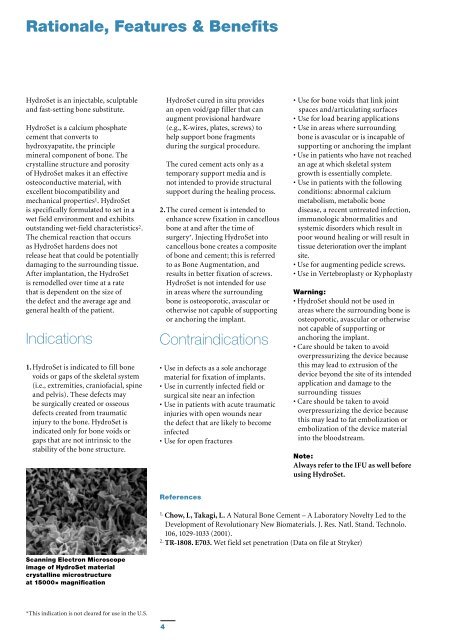HydroSet Brochure - Stryker
HydroSet Brochure - Stryker
HydroSet Brochure - Stryker
Create successful ePaper yourself
Turn your PDF publications into a flip-book with our unique Google optimized e-Paper software.
Rationale, Features & Benefits<br />
<strong>HydroSet</strong> is an injectable, sculptable<br />
and fast-setting bone substitute.<br />
<strong>HydroSet</strong> is a calcium phosphate<br />
cement that converts to<br />
hydroxyapatite, the principle<br />
mineral component of bone. The<br />
crystalline structure and porosity<br />
of <strong>HydroSet</strong> makes it an effective<br />
osteoconductive material, with<br />
excellent biocompatibility and<br />
mechanical properties 1 . <strong>HydroSet</strong><br />
is specifically formulated to set in a<br />
wet field environment and exhibits<br />
outstanding wet-field characteristics 2 .<br />
The chemical reaction that occurs<br />
as <strong>HydroSet</strong> hardens does not<br />
release heat that could be potentially<br />
damaging to the surrounding tissue.<br />
After implantation, the <strong>HydroSet</strong><br />
is remodelled over time at a rate<br />
that is dependent on the size of<br />
the defect and the average age and<br />
general health of the patient.<br />
Indications<br />
1. <strong>HydroSet</strong> is indicated to fill bone<br />
voids or gaps of the skeletal system<br />
(i.e., extremities, craniofacial, spine<br />
and pelvis). These defects may<br />
be surgically created or osseous<br />
defects created from traumatic<br />
injury to the bone. <strong>HydroSet</strong> is<br />
indicated only for bone voids or<br />
gaps that are not intrinsic to the<br />
stability of the bone structure.<br />
<strong>HydroSet</strong> cured in situ provides<br />
an open void/gap filler that can<br />
augment provisional hardware<br />
(e.g., K-wires, plates, screws) to<br />
help support bone fragments<br />
during the surgical procedure.<br />
The cured cement acts only as a<br />
temporary support media and is<br />
not intended to provide structural<br />
support during the healing process.<br />
2. The cured cement is intended to<br />
enhance screw fixation in cancellous<br />
bone at and after the time of<br />
surgery*. Injecting <strong>HydroSet</strong> into<br />
cancellous bone creates a composite<br />
of bone and cement; this is referred<br />
to as Bone Augmentation, and<br />
results in better fixation of screws.<br />
<strong>HydroSet</strong> is not intended for use<br />
in areas where the surrounding<br />
bone is osteoporotic, avascular or<br />
otherwise not capable of supporting<br />
or anchoring the implant.<br />
Contraindications<br />
• Use in defects as a sole anchorage<br />
material for fixation of implants.<br />
• Use in currently infected field or<br />
surgical site near an infection<br />
• Use in patients with acute traumatic<br />
injuries with open wounds near<br />
the defect that are likely to become<br />
infected<br />
• Use for open fractures<br />
• Use for bone voids that link joint<br />
spaces and/articulating surfaces<br />
• Use for load bearing applications<br />
• Use in areas where surrounding<br />
bone is avascular or is incapable of<br />
supporting or anchoring the implant<br />
• Use in patients who have not reached<br />
an age at which skeletal system<br />
growth is essentially complete.<br />
• Use in patients with the following<br />
conditions: abnormal calcium<br />
metabolism, metabolic bone<br />
disease, a recent untreated infection,<br />
immunologic abnormalities and<br />
systemic disorders which result in<br />
poor wound healing or will result in<br />
tissue deterioration over the implant<br />
site.<br />
• Use for augmenting pedicle screws.<br />
• Use in Vertebroplasty or Kyphoplasty<br />
Warning:<br />
• <strong>HydroSet</strong> should not be used in<br />
areas where the surrounding bone is<br />
osteoporotic, avascular or otherwise<br />
not capable of supporting or<br />
anchoring the implant.<br />
• Care should be taken to avoid<br />
overpressurizing the device because<br />
this may lead to extrusion of the<br />
device beyond the site of its intended<br />
application and damage to the<br />
surrounding tissues<br />
• Care should be taken to avoid<br />
overpressurizing the device because<br />
this may lead to fat embolization or<br />
embolization of the device material<br />
into the bloodstream.<br />
Note:<br />
Always refer to the IFU as well before<br />
using <strong>HydroSet</strong>.<br />
References<br />
1.<br />
Chow, L, Takagi, L. A Natural Bone Cement – A Laboratory Novelty Led to the<br />
Development of Revolutionary New Biomaterials. J. Res. Natl. Stand. Technolo.<br />
106, 1029-1033 (2001).<br />
2.<br />
TR-1808. E703. Wet field set penetration (Data on file at <strong>Stryker</strong>)<br />
Scanning Electron Microscope<br />
image of <strong>HydroSet</strong> material<br />
crystalline microstructure<br />
at 15000× magnification<br />
*This indication is not cleared for use in the U.S.<br />
4

















